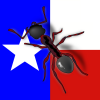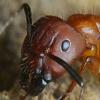I ordered some acrylic boxes, 5x5x5 inches and made this setup for a pogonomyrmex barbatus queen once she gets her nanitics. Does this look like a place they would like to nest in?
Just a few questions I really need answered as well:
1. Is a room tempature of 70 - 75 degrees F a tempature that is idle for them?
2. Do you recomend that I put a heat pad under half of the box or below the entire thing?
3. I have a spray bottle of water to moisturize my natural nests. What fraction should I spray of the ground and how often?
If you can answer all of those questions, I truely thank you! ![]()















